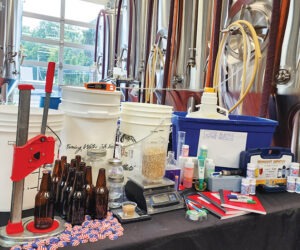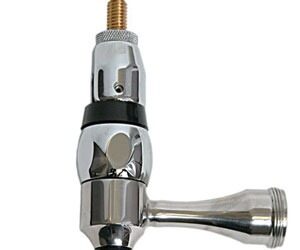Refurbishing Corny Kegs
You’ve decided to switch from bottles to kegs. Now what? The obvious first step is to obtain a keg. If you buy a new keg or choose one that’s been refurbished by a pro, this primer will tell you how to keep it in tip-top condition over time. If you find a really nasty one — like the one I bought — this article will tell you how to fix it up.
There are many different types of kegs. Beer kegs, the kind you see at parties, are used exclusively for holding beer. They have locking devices built into the keg valves so the average consumer can’t open them (you need a special tool). “Beverage kegs,” usually used for syrup and soda pop, have tops that are easy to remove. This makes them the container of choice for most homebrewers.
Beverage kegs generally come in two varieties — pin-lock kegs, which were designed for the Coca-Cola company, and the ball-lock style employed by everyone else. The names come from the style of inlet and outlet attachments. Pin-lock kegs have pins and a twist-on locking system, while ball-lock kegs use a simpler snap-on connection.
Bob Sulier of Sabco Industries, a company that sells both new and refurbished kegs, says the vast majority of calls he receives concern ball-lock kegs. Ball-lock kegs are easy to find and therefore more common among the homebrew crowd. Pin-lock kegs are a bit tougher to locate, mostly because the Coca-Cola company tends to scrap its old kegs instead of selling them. You might find some that have been discarded, for example, by a bottling plant in your area.
Whether ball-lock or pin-lock, most of these so-called “Cornelius” kegs originally contained concentrated beverage syrup that was dispensed under high pressure and mixed at the soda fountain. They range in size from 2.5 to 10 gallons, though the 5-gallon size is most common. Expect to discover ancient syrup in any old “Corny” keg you purchase, and expect that syrup to have permanently flavored any part that’s not made of stainless. These parts can be replaced and we will explain this a bit later.
Step One: Finding the Keg
A friend says he has a line on used kegs “for a couple of bucks each.” It sounds like a good deal, until you see them. They’re nasty and gooey, rusty and dented. Should you buy or pass?
Small dents on the body, the cylinder, generally don’t mean much. If a tank has a crease, a place where the metal has folded sharply, it’s only good for the shredder. Bent entry or exit ports, whether pin-lock or ball-lock fittings, might mean you cannot attach your hoses. A dent around the keg lid might mean it will never seal properly.
If the dents in the cylinder are truly minor, it’s no problem. You should be able to straighten keg fittings if they are only a few degrees off-kilter. And a dented lid or sealing surface may respond to a few gentle taps with opposing hammers. But once metal is severely dented, the metal is stretched and can never be perfectly flat. If this is the case, don’t hesitate to say “no thanks” to your friend.
However you obtain your keg, remember one point of homebrewing ethics: Keeping a beer keg from last night’s party and calling the deposit your “purchase fee” is illegal. Plus, it imposes a big financial burden on the breweries and liquor stores that need to replace them.
Step Two: Cleaning the Keg
You’ll have a hard time finding a keg that’s much dirtier than mine, but they are out there. The first step is to clean the outer surface with a good cleaning solution, like PBW (Powder Brewery Wash) or Simple Green. A brush or nylon scrub pad will remove most of the junk. Once the sides, top and fittings are as clean as you can get them, its time to start disassembling the keg.
Step Three: Flush the Inside
Remove the lid by pulling up on the bail. Flush the keg with hot water a few times to remove any remaining syrup. Add some cleaning solution — PBW or your favorite — and slosh it around. Then soak and scrub until the inside is pristine.
Step Four: Remove the Fittings
Remove the male keg fittings and toss them into some cleaning solution. This process is no more difficult than removing a spark plug from your lawnmower. For ball-lock fittings, you need a 7/8-inch deep socket and socket wrench. For pin-lock fittings, a 13/16-inch socket can be modified with special cuts to accommodate the pins. You can make your own socket with a Dremel tool or buy one from a homebrew supply store that carries keg parts and tools.
Next, remove the short gas dip tube and the long beer dip tube. The gas dip tube may be made of nylon or stainless steel. (You may want to replace a nylon tube, since it absorbs soda flavor.) Toss the short gas dip tube into the cleaner and run cleaner through the beer dip tube until you’re sure it is clean. You may need a special dip tube brush to remove debris. (You can find a dip-tube brush at any homebrew supply shop that sells keg parts.)
Step Five: Scrub and Scrub
Clean all the surfaces of the keg, inside and out, with a scrub brush and your cleaning solution of choice. Pay particular attention to the places where the male keg fittings will seat. Use a toothbrush to clean all the crevices. Next, clean the male keg fittings, especially the inner threaded portion and seating surface. Check for nicks or bumps. If the bottom of the fitting is severely distressed or the threads are messed up, replace it. Many homebrew supply shops carry replacement fittings for kegs.
Don’t worry too much about mistaking which fitting is which; the gas-in fitting of ball-lock kegs has a slot in the lower tightening nut. Pin-locks use two pins on the gas side and three pins on the beer side. If your lid has a gas relief valve you might want to replace it to remove any remaining odors. It should simply unscrew or unbolt. A note: Just on principal, you probably should replace all gaskets when you first rehab your keg. You shouldn’t need to replace them again unless something springs a leak.
Step Six: Pretty Little Poppets
Male fittings have poppet valves to permit gas or beer to move into or out of the keg. Make sure you’ve run some cleaner through the seating surface by gently pushing down on the center of the fitting until it depresses. This may cause the poppet to push completely out. Don’t worry if it does, just be sure to line it up with the center hole when tightening onto the keg.
You’ll only need to replace the poppet valve if you find a leak. Pressure-test your keg at 25 to 50 pounds per square inch (psi) before its first use. To do this, attach your gas-in hose and pin-lock or ball-lock connection and pressurize the keg. This is exactly the procedure you’ll use when carbonating your beer, and you want to find any leaks before your precious homebrew enters the keg.
If you find a leak, press the leaking poppet out from the top, and press a new one gently in from below. The new poppet may not stay in the housing. Don’t worry, just center it up when screwing the male fitting back on.
Step Seven: The Sugar Test
Fill the keg with iodophor solution. If there is any remaining sugar or starch it will reveal itself by turning into visible black specks or streaks on the surface. If you see any streaks, scrub some more!
Step Eight: Sanitize the Keg
If you clean with PBW, as I do, neutralize the cleaner and sanitize at the same time by spraying or filling with StarSan. If you use another cleanser you’ll still need to sanitize your keg before using. Regardless of what cleanser you decide to use, sanitize and let all of the parts air dry, then reassemble. All you need to do now is give your keg a final pressure test at 25 to 50 psi.
Step Nine: Admire Your Keg
It’s shiny, it’s sparkling, and this is absolutely the same nasty keg we started with. The entire process of cleaning and refurbishing one keg took me about an hour. In just a few more minutes, you could probably do four. So don’t let kegs that are merely dirty prevent you from making your homebrewing experience much simpler. Instead of waiting weeks for your beer to condition, have it ready in just two days.



